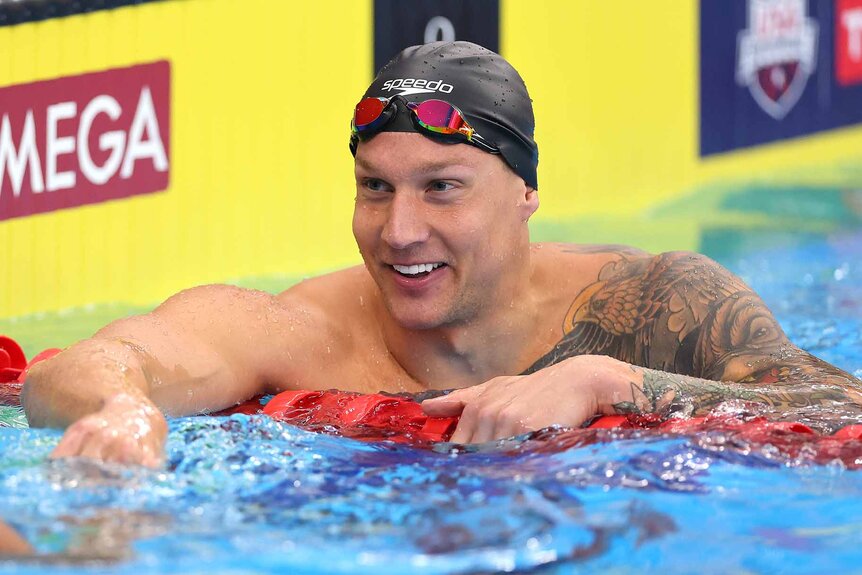Here's Everything to Know About Olympic Swimming, Including the Rules of the Race
From strokes to rules, when it comes to the pool during the 2024 Paris Games, we’ve got you covered.
While the emblematic tenets of the Olympic spirit will be on full display when many of the world’s most talented athletes descend on Paris, France for the 2024 Olympic Games in July, Team USA’s brightest stars seek to remind global audiences of another long-standing tradition when it comes to America’s participation: dominance. Owning the record for the most Olympic medals with 1,061 golds, 831 silvers, and 737 bronzes, Team USA has been so successful at imposing its will throughout the course of history, topping the medal table on 18 separate occasions, that there’s an intrinsic expectation to win and win big.
For any naysayers out there, just take a look at the elite athletes planning to rep the Stars & Stripes in the City of Light. Women’s artistic gymnastics will most likely be a familiar, fear-inducing juggernaut of Suni Lee, Gabby Douglas and Simone Biles. When it comes to basketball, legendary champions Steph Curry, LeBron James and Kevin Durant will anchor one of the best squads the United States has ever amassed since the immaculate 1992 Dream Team. Then there’s the tennis superstar Coco Gauff, track and field hopefuls Sha’Carri Richardson and Noah Lyles and the formidable wrestler Fred Richards.
RELATED: Everything to Know About the 2024 Paris Olympic Village
Still, as spectacular as those athletes are, there’s another Olympic crown jewel for America that plans to make perhaps the biggest splash of all at the Summer Games: pool swimming. Lest we forget, before Jason Momoa, this is the sport that birthed the original aqua man, Michael Phelps. Helping to pad America’s world-leading 579 Olympic medals, Team USA’s spectacularly amphibious legend remains the most decorated Olympian of all time with 28 medals and, while he longer competes, he left Team USA swimming in very capable hands.
Who are the athletes?
Between the two-headed monster of Katie Ledecky and Caeleb Dressel, the undisputed fastest swimmer in the world, Team USA’s pillars of the pool each own a whopping seven golds, in addition to Ledecky’s three silvers, and both titans are primed to gobble up more hardware as they square off against the world’s best, like France’s Leon Marchand and Canada’s Summer McIntosh.
Adding to the Americans’ depth are three-time Olympic medalist Regan Smith; top male sprint swimmer Jake Alexy, who is expected to make his Olympic debut in Paris; and Kate Douglas, a freestyle and breaststroke specialist with one bronze, earned at 2020 Games in Tokyo, Japan. But before any of the American hopefuls can take their patriotic podium bows, here’s a look at everything you need to know when it comes to Olympic swimming at the 2024 Summer Games.
What are the strokes?
As ancient as the act of swimming is, it only became a popular competitive sport in the 19th century with most swimmers utilizing a form of the breaststroke before three additional strokes were later added. In the modern Olympics, per NBC, the freestyle stroke is contested in more Olympic events than any other stroke. The backstroke and the butterfly, the most physically exhaustive and technical stroke of the four, round out the remaining swimming disciplines Olympic spectators will see in Paris, France this July.
RELATED: Snoop Dogg's Headed to the Paris Olympics and Hopes to Meet His "Favorite" Competitor
What are the swimming cuts?
Set by USA Swimming, the national governing body for swimming in the United States, “cuts” are the time standards that swimmers, from youth to Olympian, must achieve in the event they enter in order to qualify for a meet. For individual events at the Paris Games, there are two types – Olympic Qualifying Time (OQT) and Olympic Consideration TIME (OCT), per World Aquatics. Those swimmers, who match or better the OQT in one or more individual events, qualify for Olympic competition automatically. Participating countries may enter two (2) athletes in the same event, only if both swimmers’ times are equivalent or under the OQT. The OCT threshold works differently. Should the OQT not yield a quota of 852 total swimmers, "World Aquatics will then invite athletes who have equalled or bettered an OCT, until the total quota of 852 athletes is reached." The qualifying period for the 2024 Olympics began in November 2022 and closes June 4. A list of the cut times for each event can be found at USA Swimming.
Rules
Contained within an eight-lane, 50-meter-long pool, competing swimmers in freestyle, breaststroke, butterfly, and individual medley (IM) events all start from their individual elevated platform (competitors in the backstroke and relay medleys start in the water, facing the pool’s edge). The starter says, “Take your mark,” triggering each athlete to assume the starting position of leaning over one’s knees to hold the platform’s front edge. The sound of a tone cues the swimmers to dive into the pool and swim under the surface only to the 15-meter mark, where they must then breach the water. The objective of any swim race is to be the fastest to touch the pool wall at the conclusion of the event’s final lap, with each lap being a single pool length.
For any event more than 50 meters, no matter the stroke, a lap turn plays a critical role in affecting a swimmer’s time because an athlete must touch the wall as he or she turns to swim another lap, according to NBC. When time is of the essence, a swift and smoothly executed turn could be the difference of a few hundredths of a second and eternal glory. Freestyle and backstroke competitors are permitted to touch the wall with their feet by doing a somersault at the wall, but athletes in butterfly and breaststroke events must touch the wall with both hands simultaneously. Competitors can remain under water after a successful turn for no more than 15 meters before they must surface and resume the event’s stroke.
Unlike other sports, when it comes to Olympic swimming, there are no false starts, so if a swimmer dives into the pool or launches off the “backstroke ledge” before the sound of the tone, they are immediately disqualified.
RELATED: Pro Surfer Carissa Moore Reflects on Decision to Retire After 2024 Olympics: "It's Strange"
Heats
Heats are how swimmers are grouped at the start of the pool swimming competitions, and according to NBC, heats can technically “refer to any single race within a swimming event, regardless of the round.” Because there are usually more swimmers than there are the standard eight lanes in an Olympic-sized swimming pool, the total number of officially entered competitors — which often exceeds 90 swimmers — will be divided by the number of lanes to calculate how many heats there will be. For each event, the heats will occur every morning, followed by the semifinals and the finals in the afternoon.
It's worth noting that just because an athlete wins a heat does not mean he or she advances to the next round of the event. One reason for that is because Olympic organizers typically reserve the last heats of the prelim round for the fastest swimmers, which often bumps out earlier competitors who may have won their heat. Another reason a heat win doesn’t automatically advance a swimmer is because an officially clocked time is the ultimate determining factor. Once all heats have concluded, only the swimmers with the fastest recorded times will advance — the top 16 for a semifinal, followed by the top eight for a final. Olympic events that are 200m and under require two semifinals, and any time there is a tie, those swimmers will compete in a head-to-head “swim off” race to decide who moves into the next round.
Schedule
Pool swimming in the 2024 Summer Games begins Saturday, July 27, and all competitive pool events will wrap up on Saturday, August 4. Though the medal races will be broadcast live, beginning at 2:30 p.m. ET, swimming super fans can ratchet up their morning routines by tuning into the preliminary races every day, starting at 5:00 a.m. ET on Peacock. Per NBC, the schedule will deviate on the final day of the swimming pool competitions, getting underway at 2:30 p.m. ET.
Venue
In terms of the venue, attendees of the live pool swimming events are in for a treat as La Défense Arena – the home of the French rugby union club, Racing 92, that also hosts major concerts from the likes of Taylor Swift and Paul McCartney — will be transformed into the Olympic Aquatics Center and contain an official 50-meter long, Olympic-sized swimming pool. Thanks to its modular, multipurpose design, a little over 660,000 gallons of water will provide the canvas for America’s best to paint their masterpiece while a roof with more than 5,000 square meters of solar panels — enough to power to the entire center — and the integration of low-carbon, recycled materials into the building’s interior construction highlight France’s commitment to environmentalism.




































